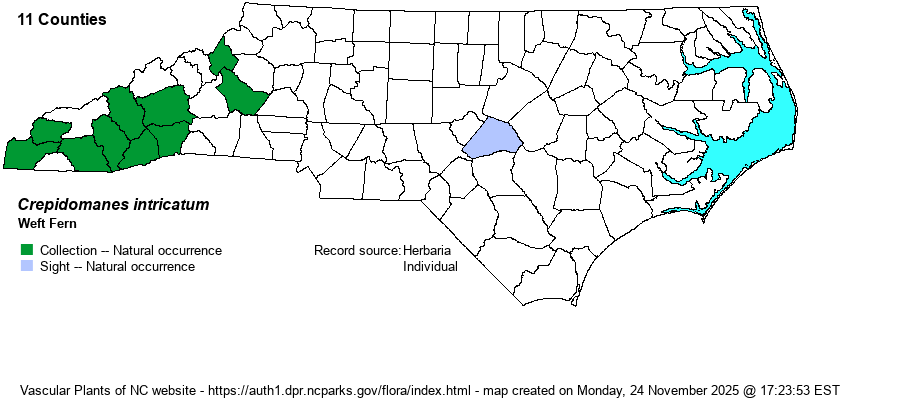| Section 2 » Family Hymenophyllaceae |
Show/Hide Synonym
| taxonName | relationship | relatedTaxonName | relatedTaxonRefText | relComments |
|---|
|
|
|
|
| Crepidomanes intricatum | = | Trichomanes intricatum | Flora of North America (1993b, 1997, 2000, 2002a, 2002b, 2003a, 2004b, 2005, 2006a, 2006b, 2006c, 2007a, 2009, 2010) | | | Crepidomanes intricatum | = | Trichomanes intricatum | | | | Crepidomanes intricatum | = | Trichomanes intricatum | | | | Crepidomanes intricatum | = | filamentous gametophyte with spindle-shaped gemmae | Radford, Ahles, and Bell (1968) | Quoted; | | Crepidomanes intricatum | = | Vandenboschia species 1 | Dubuisson et al. (2003). | | | Source: Weakley's Flora |
|
| Author | (Farrar) Ebihara & Weakley | |
| Distribution | Present nearly exclusively in the Mountains, and there mainly the southern half of the region. There is also a disjunct record in the exterme eastern Piedmont in Raven Rock State Park (Harnett County).
This is mostly a Northern species, ranging from New England west to IL, and south to western NC, northern GA, and northern AL. | |
| Abundance | Poorly known, but as it has been collected from 11 counties in the Mountains, it likely is not rare. Also, it is certainly overlooked as a moss. As NCNHP gives a State Rank of S3 and does not have it on its Watch List, it is best called uncommon to possibly locally fairly common in the mountains (especially in the gorges region near the GA/SC border), and extremely rare in the eastern Piedmont. | |
| Habitat | From the Digital Atlas of the Virginia Flora website: "Sheltered crevices and recesses of mesic to wet cliffs and outcrops." From Weakley (2018): "On ceilings or back walls of grottoes, especially in humid gorges or near or behind waterfalls." In other states also known from dry ceilings of rock recesses. |
| Phenology | Uncertain; more information needed. | |
| Identification | From the New York Natural Heritage Program website: "Trichomanes [= Crepidomanes] intricatum occurs only as its vegetative form (gametophyte) with sexually reproducing forms (sporophytes) as yet undocumented. The gametophyte is entirely filamentous, much branched, and remains persistent after maturity. Its cup-like cluster of cells (gemmae) are composed of short filaments of undifferentiated cells. Although individual gametophytes may be only a few millimeters thick, they may grow together in moss-like mats up to a square meter in size. This species is only known only from the gametophyte generation, as no sporophytes have ever been documented. It is more likely to be quickly passed over as a moss or liverwort than confused with another fern, and is the only Trichomanes known from New York. The filamentous gametophytes of Trichomanes can be distinguished from algae and from the thread-like chains of cells (protonema) in the haploid phase of mosses by their short cells with numerous disc-shaped chloroplasts, by the presence of short, brown, unicellular rhizoids, and by their production of specialized gemmifer cells and gemmae (FNA 1993)." To better understand what it looks like, please see images on Google. | |
| Taxonomic Comments | This species had been placed in the genus Trichomanes, as T. intricatum. In 2011, it was moved to a different genus -- Crepidomanes. Weakley (2018) contains much information on the taxonomic history of this very odd species.
| |
| Other Common Name(s) | Grotto-felt, Appalachian Trichomanes, Appalachian Bristle-fern. Weft Fern is the common name used by NatureServe, on Wikipedia, iNaturalist, and a few other websites. | |
| State Rank | S3 | |
| Global Rank | G4G5 | |
| State Status | | |
| US Status | | |
| USACE-agcp | | |
| USACE-emp | | |

